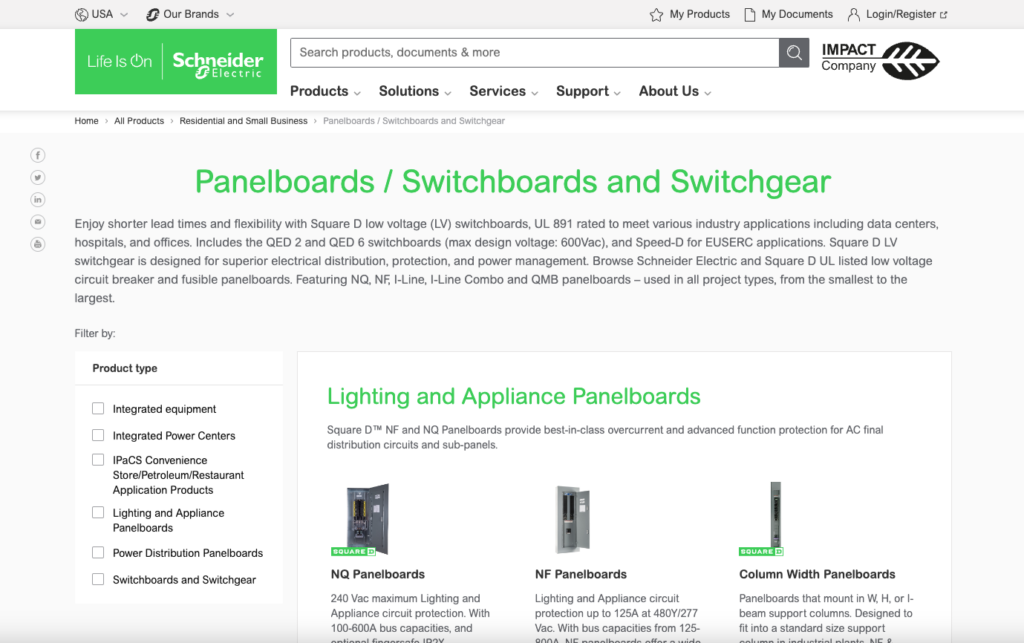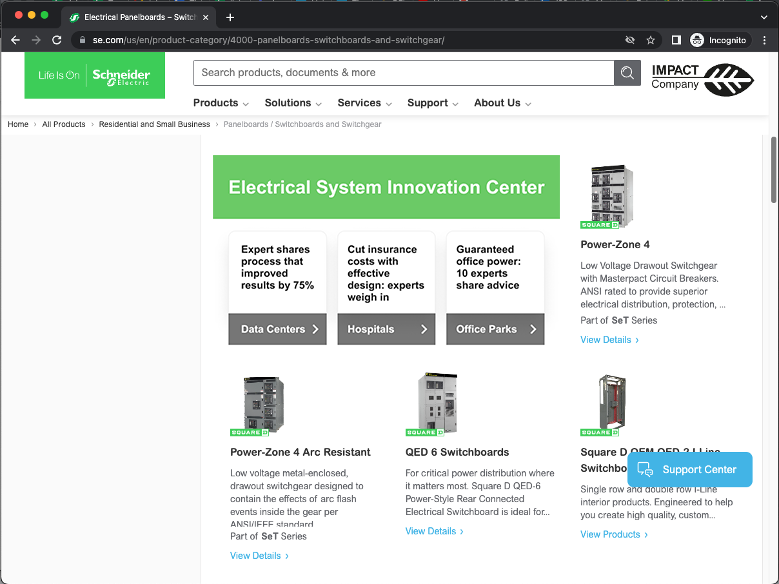Building links to a category page about… Panelboards? Switchboards? Switchgear?
Where do you even start with a page like this on se.com?
Here’s the above the scroll view on desktop (doubtful there’s much mobile traffic):

OOF.
Visit the page then come back as we unpack our approach to building links into seemingly inscrutable, obscure or otherwise deeply unfamiliar B2B offerings.
ARTICLE TOC / QUICKNAV:
Always Start With The Page
We always – no matter the vertical – begin with the page itself to learn how its offering is positioned, and who it’s positioned for. If you haven’t visited already, check it out now.
>> Stated use case of page’s offering:
Panelboards are “rated to meet various industry applications including data centers, hospitals, and offices.”
Got it… used in new construction of buildings such as:
- data centers
- hospitals
- offices
>> Benefits:
Panelboards are “designed for superior electrical distribution, protection, and power management”
So it seems that electrical systems in new construction require:
- Superior electrical distribution
- Protection
- Power management
So though the page doesn’t state its audience we can guess it would include people involved in building complex commercial buildings.
Leap From Key Uses and Benefits to Target Audiences for Link Building
From a link building perspective we’re asking what unique, useful information can we add to the page that would inform each of the stakeholder groups, the people who stand to benefit from the panelboards, switchboards and switchgear?
Secondarily… how do we align these on-page elements with topics appropriate to the publishers who address each of these particular stakeholders?
For this exercise (in which we’ve had no formal discussion with the company) we make an educated guess about this list of stakeholders.
It’s important to capture as many as possible, especially for offerings that are not common-knowledge, regularly encountered items (like… couches for example).
Please note as well – these stakeholders are not necessarily target markets worth pursuing from a lead gen perspective.
They’re on our list for link building campaign ideation purposes, as we build out topical and relevant angles from which to link to the page. There may be some overlooked stakeholders though who have undue or unexpected influence on the panelboard purchase decision.
Stakeholder Lists + Campaigns for Panelboards, Switchboards and Switchgear
This list is our best guess at some of the stakeholders involved in the development of say, a new hospital, or data center. These collective stakeholders are the audiences to whom Panelboards (etc) must be made relevant, that is, if we want to build enough links to overtake the competition!
1. Business/Organizational Visionaries
Board, CEO + advisors, leadership team). The originators of the edict to build a new building to house a fully functional data center, hospital, office, etc…
- Offering-Specific Challenges:
- Justifying cost of key facility systems to financial stakeholders.
- Ensuring the facility’s key functionality – uptime, steady production, etc.
- Effectively communicating construction slowdowns, hold ups and other unexpected events
- Applied Expertise (as Onpage Citable Elements):
- Calculator showing bottom-line impact of the electrical system on various groups within Data Centers, Hospitals, Offices, etc…
- “Plain English” communication advice for discussing most-common issues or hang ups within electrical systems installations.
- Audience-Facing Publishers:
- Business leadership publications.
- Data center, hospital, office park, commercial construction/engineering trade publications.
- Websites/blogs of electrical systems designers and installers.
- Websites/blogs of construction, engineering, architecture and other systems-design firms.
- Campaign Concepts:
- “The Big Pitch: Communicating the Value of Key Systems in Vital Facility Construction Projects”
- “Common Pitfalls to Getting Facility Construction Done On Time and Under Budget”
2. Project Manager (internal to organization or Owner’s Rep / Construction Project Manager)
Key person who’s in charge of making the building a reality. These concepts are presented separately than the visionaries audience, but could probably appeal to that audience fairly easily.
- Offering-Specific Challenges:
- Unexpected Electrical Systems Slowdowns – where, when, why they commonly occur
- Applied Expertise (Onpage Citable Elements):
- Most-Common Issues in Facility Electrical Systems Design and Implementation
- Explaining and justifying time and money investments in Effective Electrical Systems Design (for Hospitals, Datacenters, Offices, etc)
- Audience-Facing Publishers:
- Websites/blogs of electrical systems designers and installers.
- Websites/blogs of construction, engineering, architecture and other systems-design firms.
- Websites/blogs of construction, engineering materials manufacturers.
- Websites/blogs of key facility systems designers and installers.
- Campaign Concepts:
- “10 Common Electrical System Design Pitfalls in Hospitals (Data Centers/Offices/Factories/etc…)”
- “10 Things to Remind the Electrical Systems Design Team About (insert facility system you’re pitching to)”
3. Architectural firm | Engineering firm
External groups responsible for designing the building to meet the business/organizational vision for the project, as well as ensuring compliance with required regulations.
- Offering-Specific Challenges:
- Understanding Key Design Considerations and Requirements for Electrical Systems (in Datacenters, Hospitals, Offices, Factories, etc)
- Creative and Effective Workarounds for When/If Key Design Considerations are Missed or Forgotten
- Applied Expertise (Onpage Citable Elements):
- High-level guidance and “rules of thumb” relating to electrical systems design at the facility level
- New developments and innovations in design for electrical systems – ideally case studies and actual examples where structural design and electrical design interacted in novel, efficiency-generating ways
- Audience-Facing Publishers:
- commercial construction/engineering/architectural trade publications, podcasts
- Campaign Concepts:
- Case studies and examples of innovations around structural and electrical design interacting. Ideally broken out by types of facilities – data centers, hospitals, offices, factories, etc…
- Sponsoring Architectural/Engineering trade shows and expositions.
4. Building’s Actual Design Team
Person/group who matches the building’s functional requirements with the systems needed to make this happen. These would not be enormously different from #3 above, though potentially more focused on very specific facility types.
5. Electrical Systems Design Team
Person/group who understands the building’s functional requirements specifically from the electrical stand point and ensures the building meets required specifications.
- Offering-Specific Challenges:
- Understanding and ensuring full, intended functionality of every room in a building. Knowing the array of objects that will be powered within the building and supporting their functioning with effective item selections.
- Knowing novel or innovative applications of panelboards (etc…) in systems designs. Lack of insight into how others have solved specific problems.
- Applied Expertise (Onpage Citable Elements):
- Call outs regarding extremes in electrical systems requirements within data centers, hospitals, offices and factories
- Novel and innovative panelboard uses by peers.
- Facility-specific findings and recommendations.
- Audience-Facing Publishers:
- Electrical systems design firms.
- Electrical engineering trade shows, trade publications, podcasts
- Websites of equipment manufacturers who sell into data centers, hospitals, offices, factories, etc…
- Campaign Concepts:
- Interviews, surveys and data studies supporting and guiding Electrical Systems Design teams towards best practices for specific facility types
- Novel applications for emerging facility types/needs etc (ie: does an AI data center have different Electrical System Design requirements than any other?)
6. Materials Purchaser
Person/group who makes and negotiates purchase decisions on behalf of key systems or possibly the entire project.
- Offering-Specific Challenges:
- Am I looking at exactly the right part/equipment? What do all the numbers, codes and acronyms mean here?
- Are we really getting the best possible cost here? Who can I talk to about that?
- Do we really need this brand or are there other brands that would work just as well for our facility?
- When do I need to order so that I will get these on time?
- Applied Expertise (Onpage Citable Elements):
- Panelboard glossary – specifically for abbreviations, numbers, types, etc
- Pricing/purchasing cost efficiency information
- Sales contact information – one click.
- Demonstrations of brand-specific value, specific to types of facilities.
- Audience-Facing Publishers:
- Materials Purchasing trade publications.
- Websites of other systems equipment manufacturers.
- Campaign Concepts:
- Negotiating tips when dealing with big brands.
- Asking the right questions about systems product quality – understanding how specific brands and manufacturers are necessary for effectively functioning facilities.
- Supply Chain Efficiency Tips
7. Construction Firm/Systems Installers
Groups responsible for constructing and installing all of the non-electrical systems.
- Offering-Specific Challenges:
- Proper Handling/Storing of Electrical Systems Equipment
- Handling/Managing Electrical Systems Design Flaws
- Need Creative Build/Installation Solutions to Unexpected, Uncommon Design Problems
- Common mistakes of Electrical Systems Designers/Installers from the perspective of (HVAC, Security, etc…)
- Applied Expertise (Onpage Citable Elements):
- Guidance for Heat/Cold/Weather-Related storage issues
- Tips on being an effective whistleblower if you notice catastrophic issues (especially if there’s data supporting that construction firms and installers frequently discover issues)
- Innovations in design or installation approach that have come from “the ground up”
- Audience-Facing Publishers:
- Construction/Installation Trade publications, podcasts
- Construction/Installation firm websites
- Campaign Concepts:
- Group Interview: Seek + publish/promote innovations from construction/installation firms.
- “Frontline Saviors: When Construction/Installation Crews Save Real Estate Developers Millions”
8. Electrical Systems Installers
Person/group responsible for the installation of the electrical systems within the facility – industrial-grade electricians. It’s possible that they will be both specialized for buildings like data centers, hospitals, factories, etc… and have attached electrical systems design services as well.
- Offering-Specific Challenges:
- Handling/Managing Electrical Systems Design Flaws
- Creative Installation Solutions to Unexpected, Uncommon Design Problems
- Code Issues that are most commonly forgotten or overlooked
- Applied Expertise (Onpage Citable Elements):
- Innovations in design or installation approach that have come from “the ground up”
- Frequently-Overlooked Code Issues
- Audience-Facing Publishers:
- Electrical Systems Design/Installation Organizations
- Campaign Concepts:
- Group Interviews: creative installation solutions
- When installers innovate – highlight impact installers have had on systems design, construction or even the equipment production side
9. End Beneficiary
(of facility-produced service or product). For hospitals we’re talking about the patients. For the data center it’s the customer. The office would be the employees and the customers of the business for which they work. Here, SE.com would need to develop a “powered by” or “SE Inside” form of branding that would bolster the marketing efforts of their customers.
Examples of Implemented citable elements
Please note: these are mockups only, to illustrate how citable elements might look once implemented:



Wrap-up:
Are there more stakeholders than these? Probably. Did we name or segment our stakeholders along industry standards? Probably not. Our intention here is sharing our approach – identify all of the stakeholders who benefit from a given product or service and then use their perspective to ask useful, expertise-required questions.
With 9 different [identified] stakeholders, each supported by differing types of publishers, that page’s content should be outshining the competition in no time.
Additionally, the link builder will have done a sort of full-spectrum exploration of the participants in the decision space for panelboards. And while not every stakeholder will care, or even want to learn about panelboards, we’ve landed on an angle for contextualizing and then linking to the page.
Resources for Further Exploration
If you’re tackling the challenge of building links to technical or niche category pages, these resources might offer some guidance:
- Link Launch Tool: A straightforward tool for planning and executing link-building campaigns for even the most challenging pages. Try it here.
- Learn More: Explore strategies for creating linkable content that works for highly specific or technical topics. Learn more here.